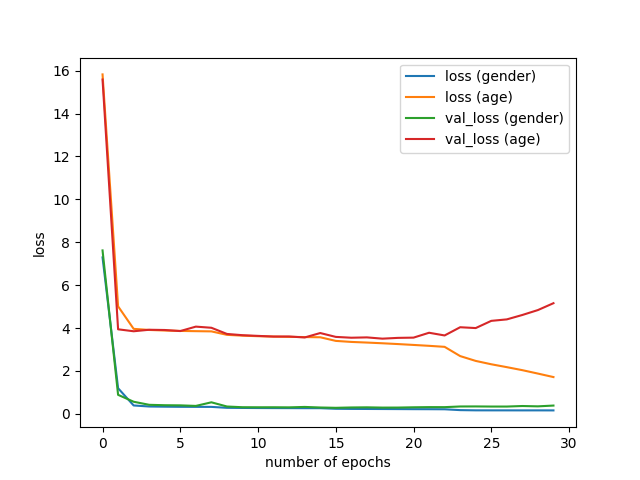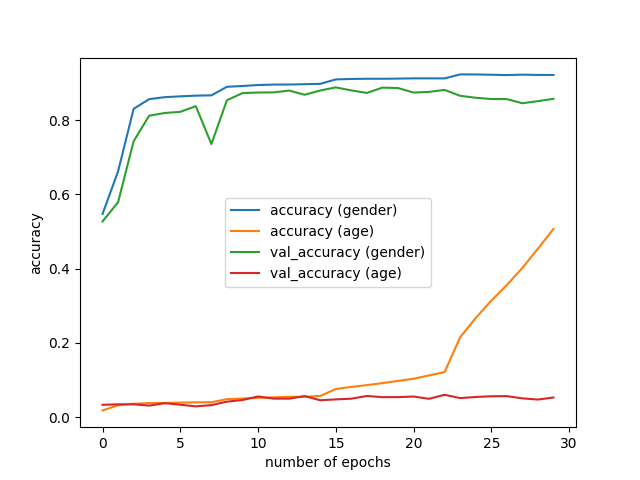This is a Keras implementation of a CNN for estimating age and gender from a face image [1, 2]. In training, the IMDB-WIKI dataset is used.
- Python3.5+
- Keras2.0+
- scipy, numpy, Pandas, tqdm, tables, h5py
- dlib (for demo)
- OpenCV3
Tested on:
- Ubuntu 16.04, Python 3.5.2, Keras 2.0.3, Tensorflow(-gpu) 1.0.1, Theano 0.9.0, CUDA 8.0, cuDNN 5.0
- CPU: i7-7700 3.60GHz, GPU: GeForce GTX1080
- macOS Sierra, Python 3.6.0, Keras 2.0.2, Tensorflow 1.0.0, Theano 0.9.0
Run demo the script (requires web cam)
python3 demo.pyThe pretrained model for TensorFlow backend will be automatically downloaded to the pretrained_models directory.
The dataset is downloaded and extracted to the data directory.
./download.shFilter out noise data and serialize images and labels for training into .mat file.
Please check check_dataset.ipynb for the details of the dataset.
python3 create_db.py --output data/imdb_db.mat --db imdb --img_size 64usage: create_db.py [-h] --output OUTPUT [--db DB] [--img_size IMG_SIZE] [--min_score MIN_SCORE]
This script cleans-up noisy labels and creates database for training.
optional arguments:
-h, --help show this help message and exit
--output OUTPUT, -o OUTPUT path to output database mat file (default: None)
--db DB dataset; wiki or imdb (default: wiki)
--img_size IMG_SIZE output image size (default: 32)
--min_score MIN_SCORE minimum face_score (default: 1.0)Train the network using the training data created above.
python3 train.py --input data/imdb_db.matTrained weight files are stored as checkpoints/weights.*.hdf5 for each epoch if the validation loss becomes minimum over previous epochs.
usage: train.py [-h] --input INPUT [--batch_size BATCH_SIZE]
[--nb_epochs NB_EPOCHS] [--depth DEPTH] [--width WIDTH]
[--validation_split VALIDATION_SPLIT] [--aug]
This script trains the CNN model for age and gender estimation.
optional arguments:
-h, --help show this help message and exit
--input INPUT, -i INPUT
path to input database mat file (default: None)
--batch_size BATCH_SIZE
batch size (default: 32)
--nb_epochs NB_EPOCHS
number of epochs (default: 30)
--depth DEPTH depth of network (should be 10, 16, 22, 28, ...)
(default: 16)
--width WIDTH width of network (default: 8)
--validation_split VALIDATION_SPLIT
validation split ratio (default: 0.1)
--aug use data augmentation if set true (default: False)Recent data augmentation methods, mixup [3] and Random Erasing [4],
can be used with standard data augmentation by --aug option in training:
python3 train.py --input data/imdb_db.mat --augPlease refer to this repository for implementation details.
I confirmed that data augmentation enables us to avoid overfitting and improves validation loss.
python3 demo.pyusage: demo.py [-h] [--weight_file WEIGHT_FILE] [--depth DEPTH] [--width WIDTH]
This script detects faces from web cam input, and estimates age and gender for
the detected faces.
optional arguments:
-h, --help show this help message and exit
--weight_file WEIGHT_FILE path to weight file (e.g. weights.18-4.06.hdf5) (default: None)
--depth DEPTH depth of network (default: 16)
--width WIDTH width of network (default: 8)
Please use the best model among checkpoints/weights.*.hdf5 for WEIGHT_FILE if you use your own trained models.
python3 plot_history.py --input models/history_16_8.h5 The best val_loss was improved from 3.969 to 3.731:
- Without data augmentation: 3.969
- With standard data augmentation: 3.799
- With mixup and random erasing: 3.731
We can see that, with data augmentation, overfitting did not occur even at very small learning rates (epoch > 15).
In the original paper [1, 2], the pretrained VGG network is adopted. Here the Wide Residual Network (WideResNet) is trained from scratch. I modified the @asmith26's implementation of the WideResNet; two classification layers (for age and gender estimation) are added on the top of the WideResNet.
Note that while age and gender are independently estimated by different two CNNs in [1, 2], in my implementation, they are simultaneously estimated using a single CNN.
Trained on imdb, tested on wiki.

[1] R. Rothe, R. Timofte, and L. V. Gool, "DEX: Deep EXpectation of apparent age from a single image," ICCV, 2015.
[2] R. Rothe, R. Timofte, and L. V. Gool, "Deep expectation of real and apparent age from a single image without facial landmarks," IJCV, 2016.
[3] H. Zhang, M. Cisse, Y. N. Dauphin, and D. Lopez-Paz, "mixup: Beyond Empirical Risk Minimization," in arXiv:1710.09412, 2017.
[4] Z. Zhong, L. Zheng, G. Kang, S. Li, and Y. Yang, "Random Erasing Data Augmentation," in arXiv:1708.04896, 2017.


